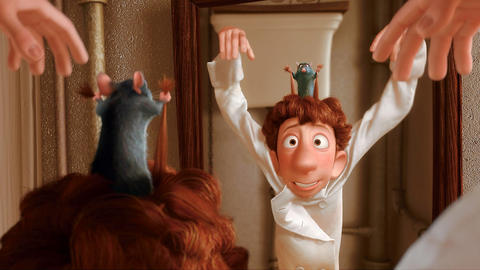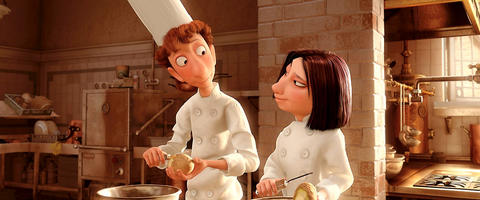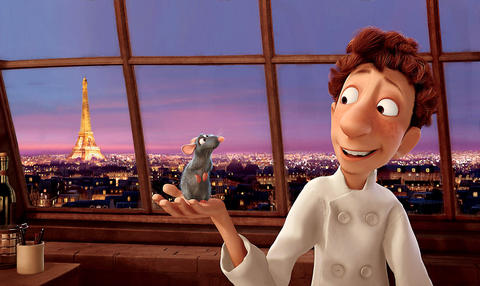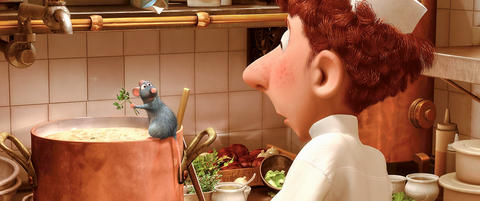The moral of Ratatouille is delivered by a critic: a gaunt, unsmiling fellow named Anton Ego who composes his acidic notices in a coffin-shaped room and who speaks in the parched baritone of Peter O'Toole. "Not everyone can be a great artist," Ego muses. "But a great artist can come from anywhere."
Quite so. Written and directed by Brad Bird and displaying the usual meticulousness associated with the Pixar brand, Ratatouille is a nearly flawless piece of popular art, as well as one of the most persuasive portraits of an artist ever committed to film. It provides the kind of deep, transporting pleasure, at once simple and sophisticated, that movies at their best have always promised.
Its sensibility, implicit in Ego's aphorism, is both exuberantly democratic and unabashedly elitist, defending good taste and aesthetic accomplishment not as snobbish entitlements but as universal ideals. Like The Incredibles, Bird's earlier film for Pixar, Ratatouille celebrates the passionate, sometimes aggressive pursuit of excellence, an impulse it also exemplifies.

PHOTOS: COURTESY OF BVI/SONY
The hero (and perhaps Bird's alter ego) is Remy (Patton Oswalt), a young rat who lives somewhere in the French countryside and conceives a passion for fine cooking. Raised by garbage-eaters, he is drawn toward a more exalted notion of food by the sensitivity of his own palate and by the example of Auguste Gusteau (Brad Garrett), a famous chef who insists - more in the manner of Julia Child than of his real-life haute cuisine counterparts - that "anyone can cook."
What Remy discovers is that anyone, including his uncultured brother, can be taught to appreciate intense and unusual flavors. (How to translate the reactions of the nose and tongue by means of sound and image is a more daunting challenge, one that the filmmakers, including Michael Giacchino, author of the marvelous musical score, meet with effortless ingenuity.) Remy's budding culinary vocation sets him on a lonely course, separating him from his clannish, philistine family and sending him off, like so many young men from the provinces before him, to seek his fortune in Paris. That city, from cobblestones to rooftops, is brilliantly imagined by the animators.
And, as usual in a Pixar movie, a whole new realm of physical texture and sensory detail has been conquered for animation. Finding Nemo found warmth in the cold-blooded, scaly creatures of the deep; Cars brought inert metal to life. At first glance, Ratatouille may look less groundbreaking, since talking furry rodents are hardly a novelty in cartoons. But the innovations are nonetheless there, in the fine grain of every image: in the matted look of wet rat fur and the bright scratches in the patina of well-used copper pots, in the beads of moisture on the surface of cut vegetables and the sauce-stained fabric of cooks' aprons.

Individually, the rats are appealing enough, but the sight of dozens of them swarming through pantries and kitchens is appropriately icky, and Bird acknowledges that interspecies understanding may have its limits.
Perhaps because animation, especially the modern computer-assisted variety, is the work of so many hands and the product of so much invested capital, we are used to identifying animated movies with their corporate authors: Disney, DreamWorks, Pixar and so on. But while the visual effects in Ratatouille show a recognizable company stamp, the sensibility that governs the story is unmistakably Bird's. A veteran of The Simpsons and a journeyman writer for movies and television, he has emerged as an original and provocative voice in American filmmaking.
He is also, at least implicitly, a severe critic of the laziness and mediocrity that characterize so much popular culture. He criticizes partly by example, by avoiding the usual kid-movie cliches and demonstrating that a clear, accessible story can also be thoughtful and unpredictable. Ratatouille features no annoying sidekick and no obtrusive celebrity voice-work, and while Remy is cute, he can also be prickly, demanding and insecure.

Moreover, his basic moral conflict - between family obligation and individual ambition - is handled with unusual subtlety and complexity, so that the reassurances and resolutions of the movie's end feel earned rather than predetermined.
And while the film buzzes with eye-pleasing action and incident - wild chases, hairbreadth escapes, the frenzied choreography of a busy kitchen - it does not try to overwhelm its audience with excessive noise and sensation. Instead Bird integrates story and spectacle with the light, sure touch that Vincente Minnelli brought to his best musicals and interweaves the tale of Remy's career with beguiling subplots and curious characters.
Since no Parisian restaurant will let a rat work in its kitchen, Remy strikes a deal with a hapless low-level worker named Linguini (Lou Romano), who executes Remy's recipes by means of an ingenious (and hilarious) form of under-the-toque puppetry. Linguini's second mentor is Colette (Janeane Garofalo), a tough sous-chef who unwittingly becomes the rodent's rival for Linguini's allegiance. Even minor figures - assistant cooks, waiters, a hapless health inspector - show remarkable individuality.

At stake in Ratatouille is not only Remy's ambition but also the hallowed legacy of Gusteau, whose ghost occasionally floats before Remy's eyes and whose restaurant is in decline. Part of the problem is Gusteau's successor, Skinner (Ian Holm), who is using the master's name and reputation to market a line of mass-produced frozen dinners.
Against him, Remy and Bird take a stand in defense of an artisanal approach that values both tradition and individual talent: classic recipes renewed by bold, creative execution. The movie's grand climax, and the source of its title, is the preparation of a rustic dish made of common vegetables - a dish made with ardor and inspiration and placed, as it happens, before a critic.
And what, faced with such a ratatouille, is a critic supposed to say? Sometimes the best response is the simplest. Sometimes "thank you" is enough.

April 28 to May 4 During the Japanese colonial era, a city’s “first” high school typically served Japanese students, while Taiwanese attended the “second” high school. Only in Taichung was this reversed. That’s because when Taichung First High School opened its doors on May 1, 1915 to serve Taiwanese students who were previously barred from secondary education, it was the only high school in town. Former principal Hideo Azukisawa threatened to quit when the government in 1922 attempted to transfer the “first” designation to a new local high school for Japanese students, leading to this unusual situation. Prior to the Taichung First

When the South Vietnamese capital of Saigon fell to the North Vietnamese forces 50 years ago this week, it prompted a mass exodus of some 2 million people — hundreds of thousands fleeing perilously on small boats across open water to escape the communist regime. Many ultimately settled in Southern California’s Orange County in an area now known as “Little Saigon,” not far from Marine Corps Base Camp Pendleton, where the first refugees were airlifted upon reaching the US. The diaspora now also has significant populations in Virginia, Texas and Washington state, as well as in countries including France and Australia.

On April 17, Chinese Nationalist Party (KMT) Chairman Eric Chu (朱立倫) launched a bold campaign to revive and revitalize the KMT base by calling for an impromptu rally at the Taipei prosecutor’s offices to protest recent arrests of KMT recall campaigners over allegations of forgery and fraud involving signatures of dead voters. The protest had no time to apply for permits and was illegal, but that played into the sense of opposition grievance at alleged weaponization of the judiciary by the Democratic Progressive Party (DPP) to “annihilate” the opposition parties. Blamed for faltering recall campaigns and faced with a KMT chair

Article 2 of the Additional Articles of the Constitution of the Republic of China (中華民國憲法增修條文) stipulates that upon a vote of no confidence in the premier, the president can dissolve the legislature within 10 days. If the legislature is dissolved, a new legislative election must be held within 60 days, and the legislators’ terms will then be reckoned from that election. Two weeks ago Taipei Mayor Chiang Wan-an (蔣萬安) of the Chinese Nationalist Party (KMT) proposed that the legislature hold a vote of no confidence in the premier and dare the president to dissolve the legislature. The legislature is currently controlled